Evolution of the MCS system
A new sidebar
Like any new technology, the first production will reveal many malfunctions. Especially, opening by forcing technique was possible on the first generation. The sidebar’s stumps was breaking in contact on the stainless steel rotors, the lock could be opened in a very quick time and without any visible external trace. Another problem was the spring allowing the locking of the sidebar, escaping from its housing on cylinders which are in great use and making the locks inoperable. For all these reasons, EVVA introduce since 1985 a new sidebar’s design (N°380,301).
Comme toute nouvelle technologie, la première production révèlera beaucoup de problèmes. Notamment, l’ouverture en force était possible sur la première génération. Les pattes de la barre latérale se brisaient en contact avec les rotors en inox, la serrure pouvait être ouverte très rapidement et sans dommages extérieurs apparents. Un autre problème était le ressort permettant le verrouillage de la barre latérale, celui-ci s’échappait de son logement sur des cylindres très utilisés et rendait la serrure inopérante. Pour toutes ces raisons, EVVA propose dès 1985 un nouveau concept de barre latérale (N°380,301).
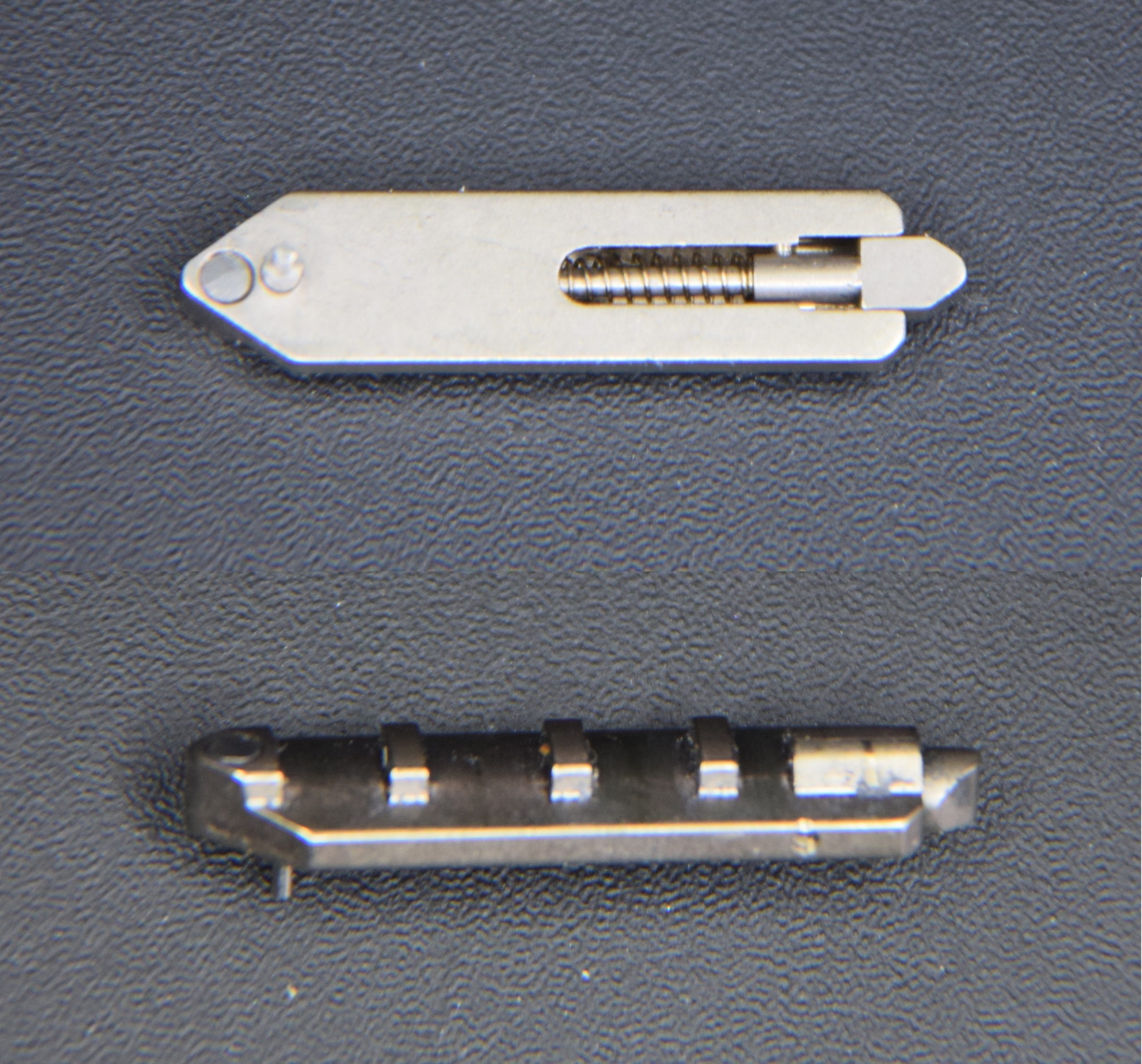
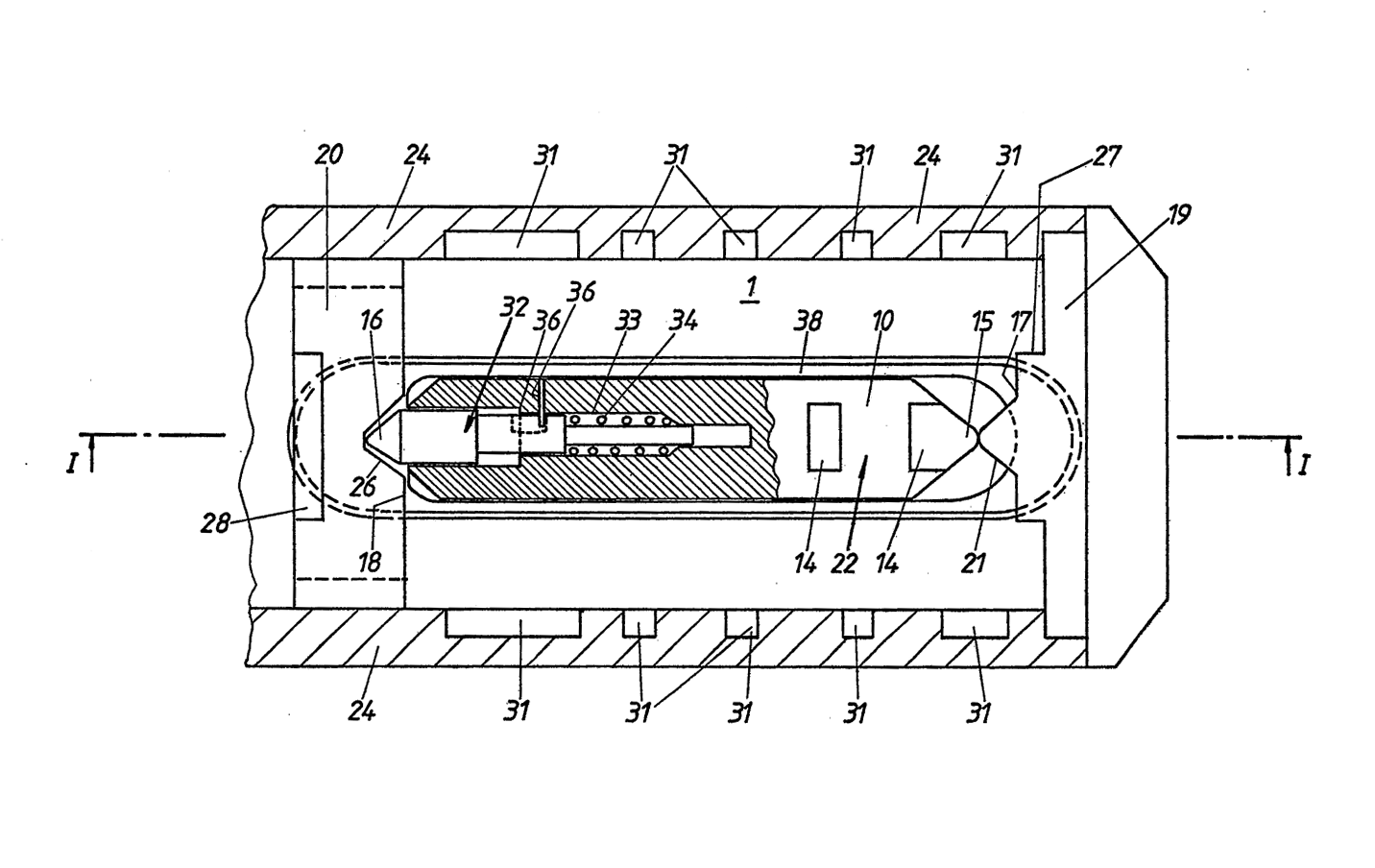

This new sidebar contains three parts : a inner sidebar, a black plastic cover and a outer sidebar. The plastic cover is fixe in its groove. The inner and outer sidebar sandwich it and can slide on both sides. The inner sidebar has three stumps and a small hole in which the outer sidebar’s stump goes through allowing to connect them during their translation. Once assembled, these two moving parts become one.
Cette nouvelle barre latérale est composée de 3 éléments : une plaque interne, une membrane en plastique noir et une barre externe. La membrane plastique est fixe dans sa rainure. La plaque interne et la barre externe sont prises en sandwich et peuvent glisser sur ces deux faces. La plaque interne possède trois petites pattes et un trou dans lequel la tige de la barre externe passe au travers permettant de les lier pendant leur translation. Une fois assembler, ces deux parties mobiles ne font plus qu’une.
How it works ?
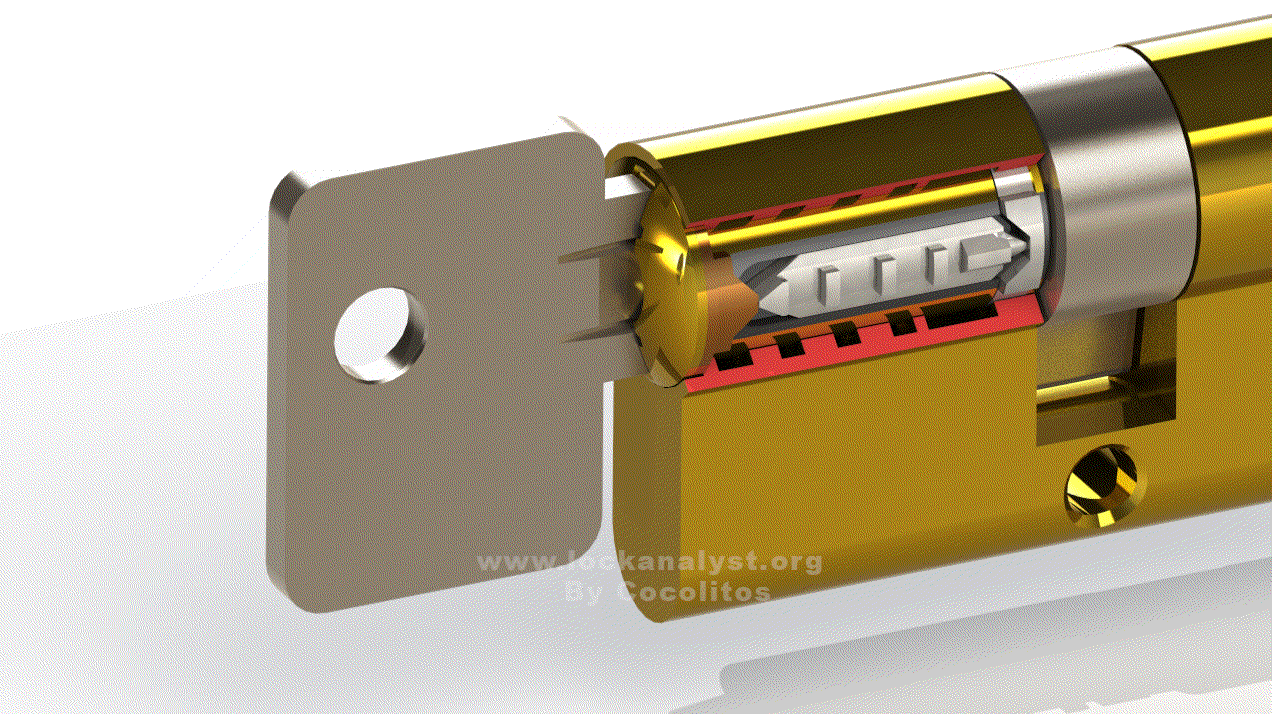
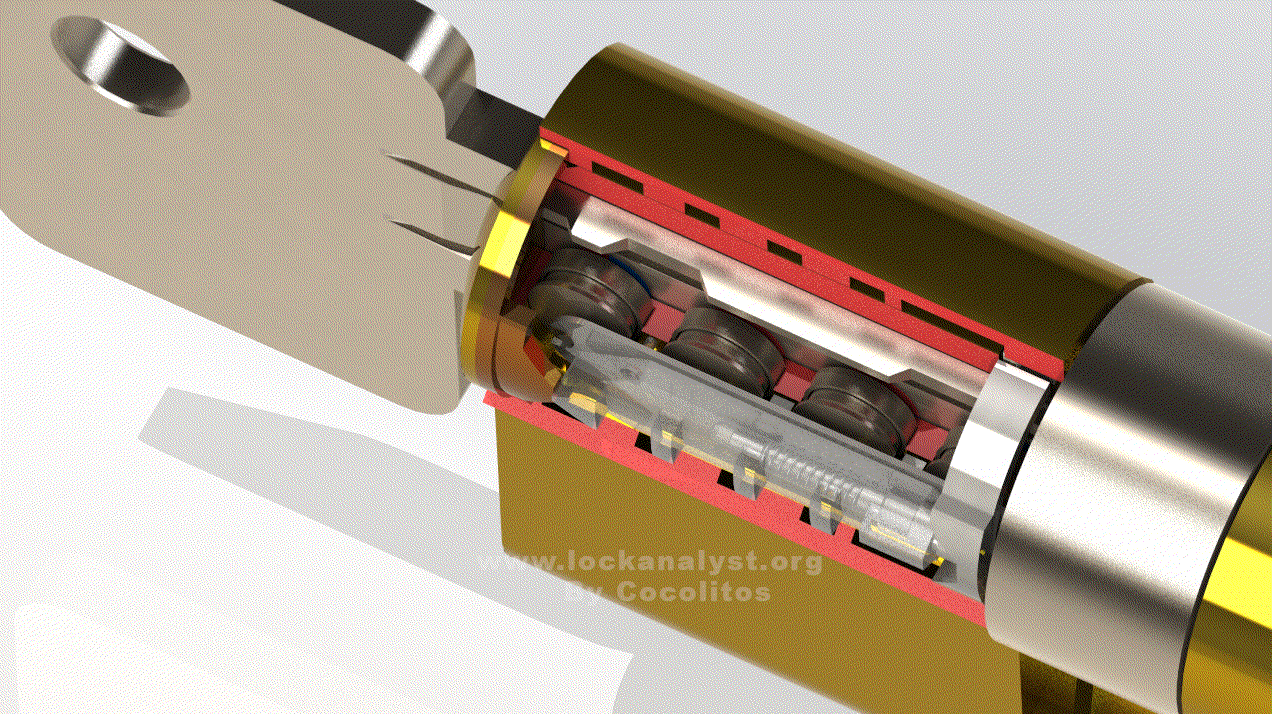
This new design work with a inner little coil spring which allows to compress the two parts sidebar. The lock has two rings allowing to move forward and backward the sidebar. The front ring (locking ring) is on contact with the outer sidebar and the back ring (unlocking ring) touch a spring-loaded pin which slide into the outer sidebar. A small pin limits its stroke. This configuration allows to reduce the contact between the last three magnetic rotors and the sidebar stumps to prevent the use of forcing technique. On the other hand, the first magnetic rotor is binded always first because it will be constrained by the outer sidebar’s stump.
The black plastic cover avoid sidebar’s corrosion, dust encrustation and also a premature wear of the mechanism by facilitating the sliding of the two locking elements. The plastic cover is made in nylon by injection molding technique, this material has very good self-lubricating properties.
Ce nouveau concept fonctionne avec un petit ressort hélicoïdal qui permet de compresser les deux éléments de la barre externe. La serrure possède deux anneaux qui ont pour fonction de la mouvoir en avant et en arrière. L’anneau le plus proche de l’entrée de clef (verrouillage) est en contact avec la barre externe et l’anneau au fond (déverrouillage) touche le nez d’une goupille qui coulisse dans la barre externe. Une petite goupille limite sa course. Cette configuration permet de réduire les contacts entre les trois derniers rotors magnétiques et les mentonnets de la plaque interne afin d’empêcher l’utilisation de clefs de force. Par contre, le premier rotor magnétique sera le plus sollicité car il sera le premier contraint par le mentonnet de la barre externe.
La membrane en plastique noir évite la corrosion de la barre latérale, l’incrustation des poussières et l’usure prématurée du mécanisme en facilitant le glissement des deux éléments de blocage. La membrane plastique est fabriquée en nylon par moulage (injection plastique), ce matériau présente d’excellentes propriétés d’auto-lubrification.
Accidental openings vs oscillations
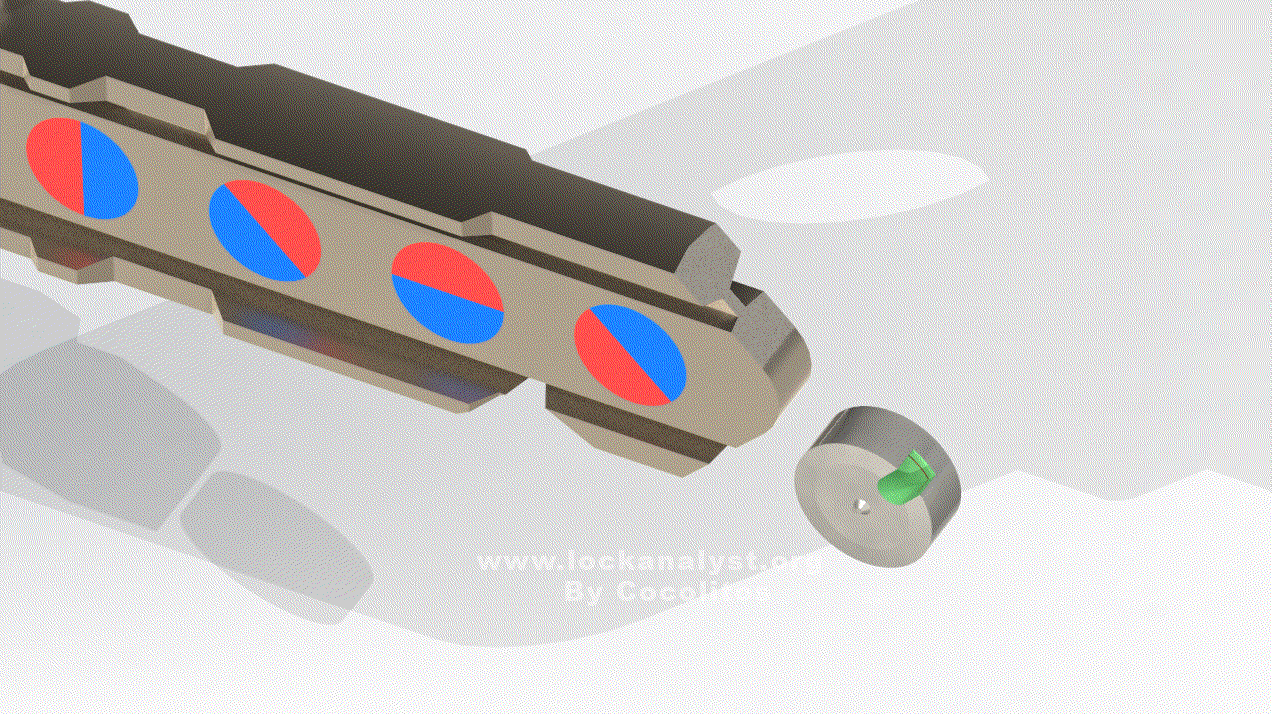
On the first generation, it happens that a correct key opens only once in three attempts. Yet the friction, which we mentioned in the previous article, was known to engineers from the start of production in 1982. As a result, the response time of the magnetic rotors is too long. A false key can simulate an approximate orientation by inserting it more or less into the lock and generate accidental partials unlockings (2).
In addition, the mass of the magnet and its stainless steel capsule creates inertia when rotating. There is no contact with the key, only the magnetic field influences the rotation of the magnetic rotor. Engineers observe a pendulum effect estimated at about ½ second causing uncertainty in the orientation of the magnetic rotor (2). The rotors position themselves less quickly than the key insertion time. A way must then be found to brake the rotor sufficiently to avoid this phenomenon.
Sur la première génération, il arrive parfois que la bonne clef ouvre une fois sur trois. Pourtant la friction que nous avons évoqué dans le précédent article, était connue des ingénieurs lors du lancement de la production en 1982. Il en résulte que le temps de réponse des rotors magnétiques est trop long. Une fausse clef pourra simuler une orientation approximative en l’insérant plus ou moins dans la serrure et générer des “entrouvertures” accidentelles (2).
De plus, la masse de l’aimant et de sa capsule en inox crée une inertie en tournant. Il n’y a aucun contact avec la clef, seul le champ magnétique influence la rotation du rotor magnétique. Les ingénieurs constatent alors un effet de pendule estimé à environ ½ seconde provocant une incertitude de l’orientation du rotor magnétique (2). Ceux-ci se positionnent moins vite que le temps d’insertion de la clef. Il faut alors trouver un moyen de freiner le rotor suffisamment pour éviter ce phénomène.
New rotor design
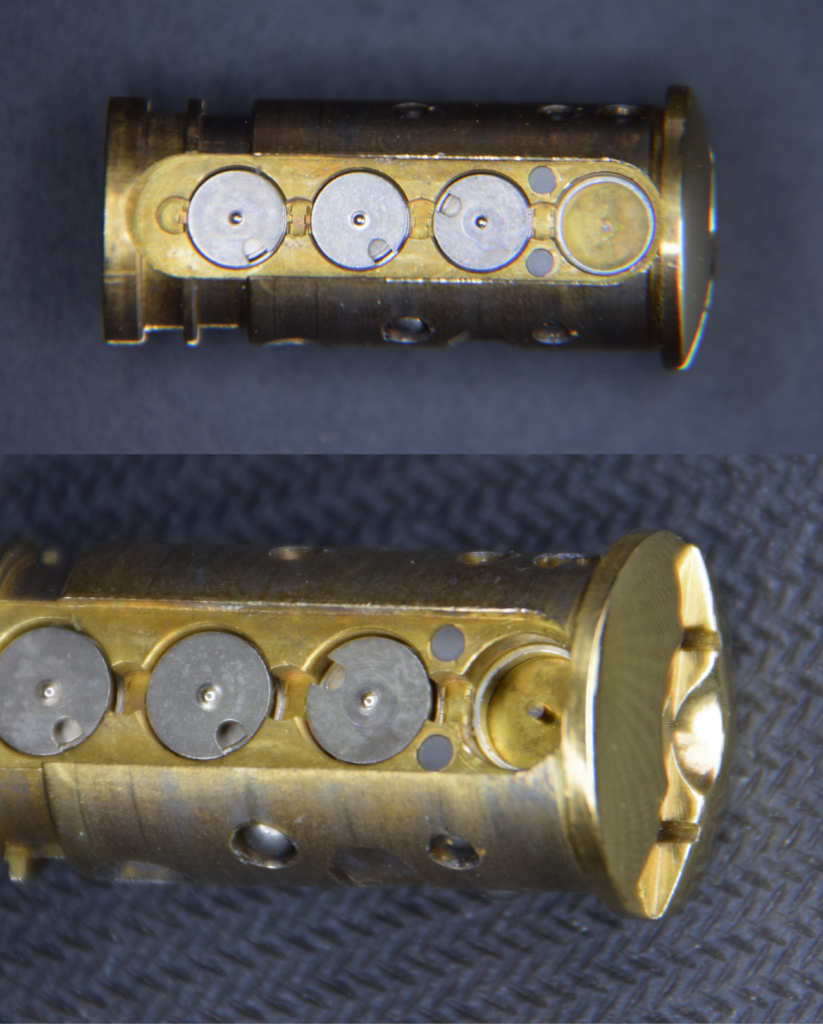
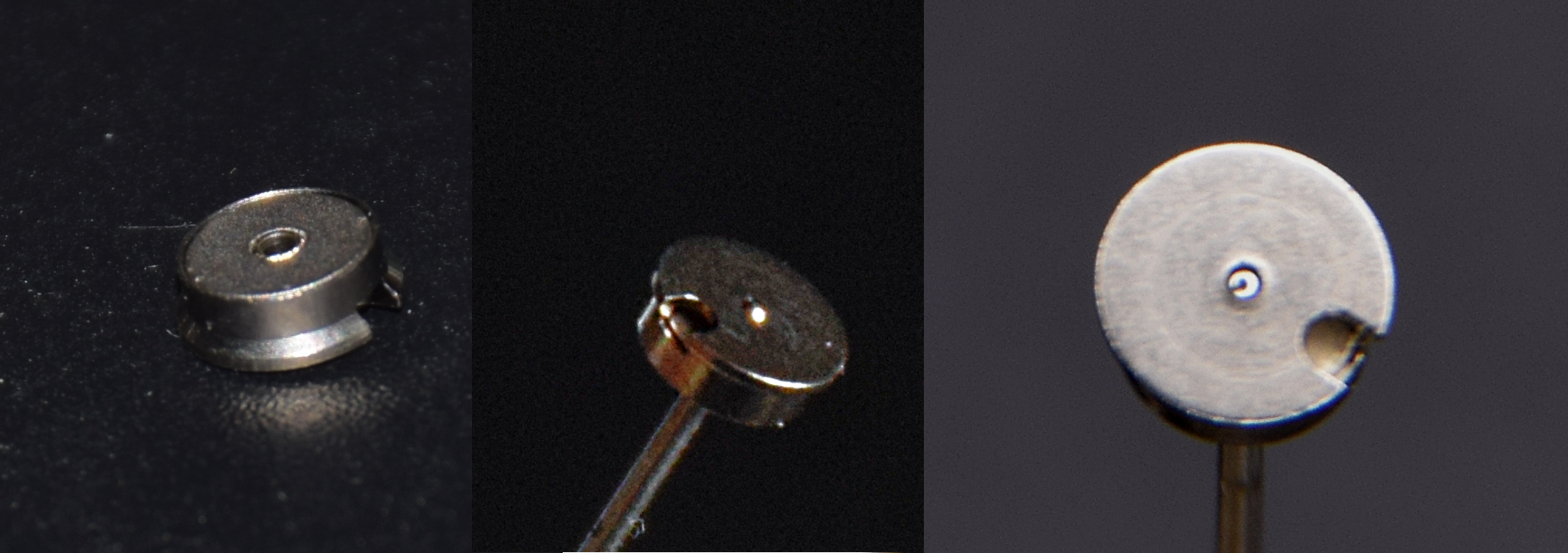
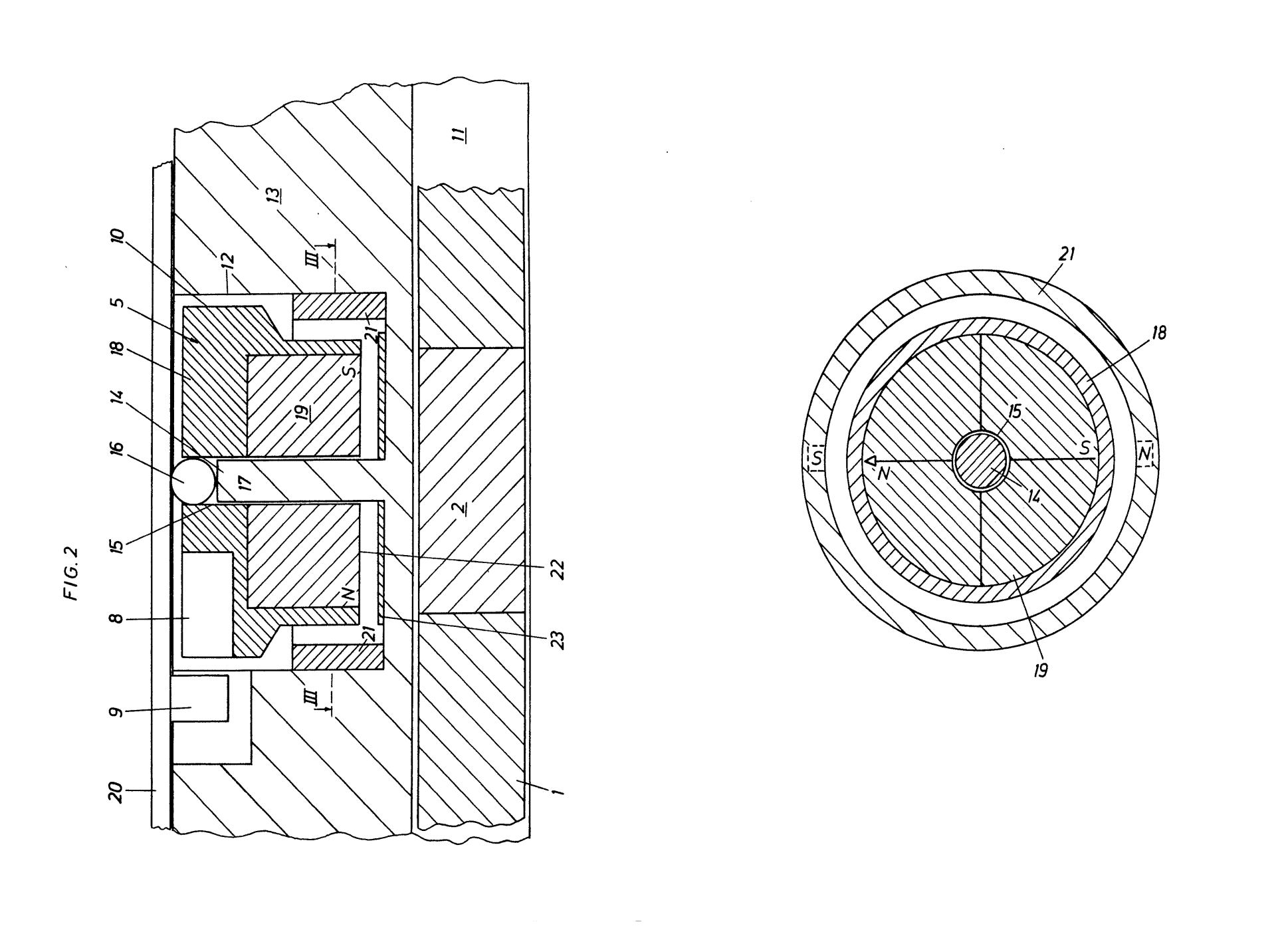
In 1988, EVVA modify the production of the magnetic rotor to resolve the oscillation problem. This new system consist to create an induced magnetic field to brake the rotor sufficiently. This design is very efficient and allows to increase the accuracy of orientation of each rotors.
This device contains a little ring made in magnetisable material (ferrit) and a rotor. A ball-bearing is punch in a small hole and sit on a rotor housing’s axis to reduce friction like a spinning tops. When no key is inserted, the rotor levitates in equilibrium under the influence of the ring’s magnetic field and the ball is in contact with the inner sidebar. When a correct key is inserted, the rotor jump up and rotate around the ball-bearing until the key stops. The magnetized ring (by the rotor magnets) brake the rotor’s inertia and the key magnet are platted at the bottom of their housing. The ring has the advantage of protecting each rotor from the magnetic field of the neighboring rotor but it keeps in memory a reverse polarity and so the orientation of magnetic rotor.
En 1988, EVVA modifie la production des rotors magnétiques afin de résoudre les problèmes d’oscillations. Ce nouveau système consiste à créer un champ magnétique induit pour freiner suffisamment le rotor. Ce concept est très efficace et permet d’augmenter la précision de l’orientation de chaque rotor.
Ce dispositif est constitué d’un petit anneau fabriqué en matériau magnétisable (ferrite) et d’un rotor. Une bille est enfoncée en force dans un petit trou et repose sur l’axe du logement du rotor afin de réduire la friction comme le ferait une toupie. Quand aucune clef est insérée, le rotor lévite en équilibre sous l’influence du champ magnétique de l’anneau et la bille est en contact avec la plaque interne. Quand la bonne clef est insérée, les rotors s’éjectent vers l’extérieur de leur logement et tournent autour de la bille jusqu’à ce que la clef soit en butée. L’anneau magnétisé (par l‘aimant du rotor) freine l’inertie du rotor et les aimants de la clef les plaquent au fond de leur logement. L’anneau a l’avantage de protéger chaque rotor du champ magnétique du rotor voisin, mais il garde en mémoire la polarité inverse et ainsi l’orientation du rotor magnétique.

After 1989, ZEISS IKON became ZI IKON and will produce a third generation with some new improvements. The reset and locking rings are made in nylon to reduce the sidebar’s friction and avoid the use of forcing technique. All magnetic rotors are made in plastic which make them as light as possible to prevent inertia effect. A new spacer is special made in stainless steel (sheet-metal) with four holes in which the rotor’s axis is housed and four oblong openings allowing the sidebar’s stumps to slide foreward. This last element separates the sliding movement of the sidebar from the rotational movement of the magnetic rotors.
Après 1989, ZEISS IKON devient ZI IKON et produira une troisième génération avec de nouvelles améliorations. Les anneaux de verrouillage et de déverrouillage sont désormais fabriqués en nylon pour réduire les frictions avec la barre latérale et empêcher l’usage des clefs de force. Tout les rotors magnétiques sont aussi en plastique afin de les alléger le plus possible pour éviter l’effet d’inertie. Une entretoise est spécialement conçue en clinquant inox avec quatres trous dans lesquels les axes des rotors viennent se loger et quatres ouvertures oblongues permettant aux mentonnets de la barre latérale de glisser vers l’avant. Ce dernier élément permet de séparer le mouvement de glissement de la barre latérale du mouvement de rotation des rotors magnétiques.
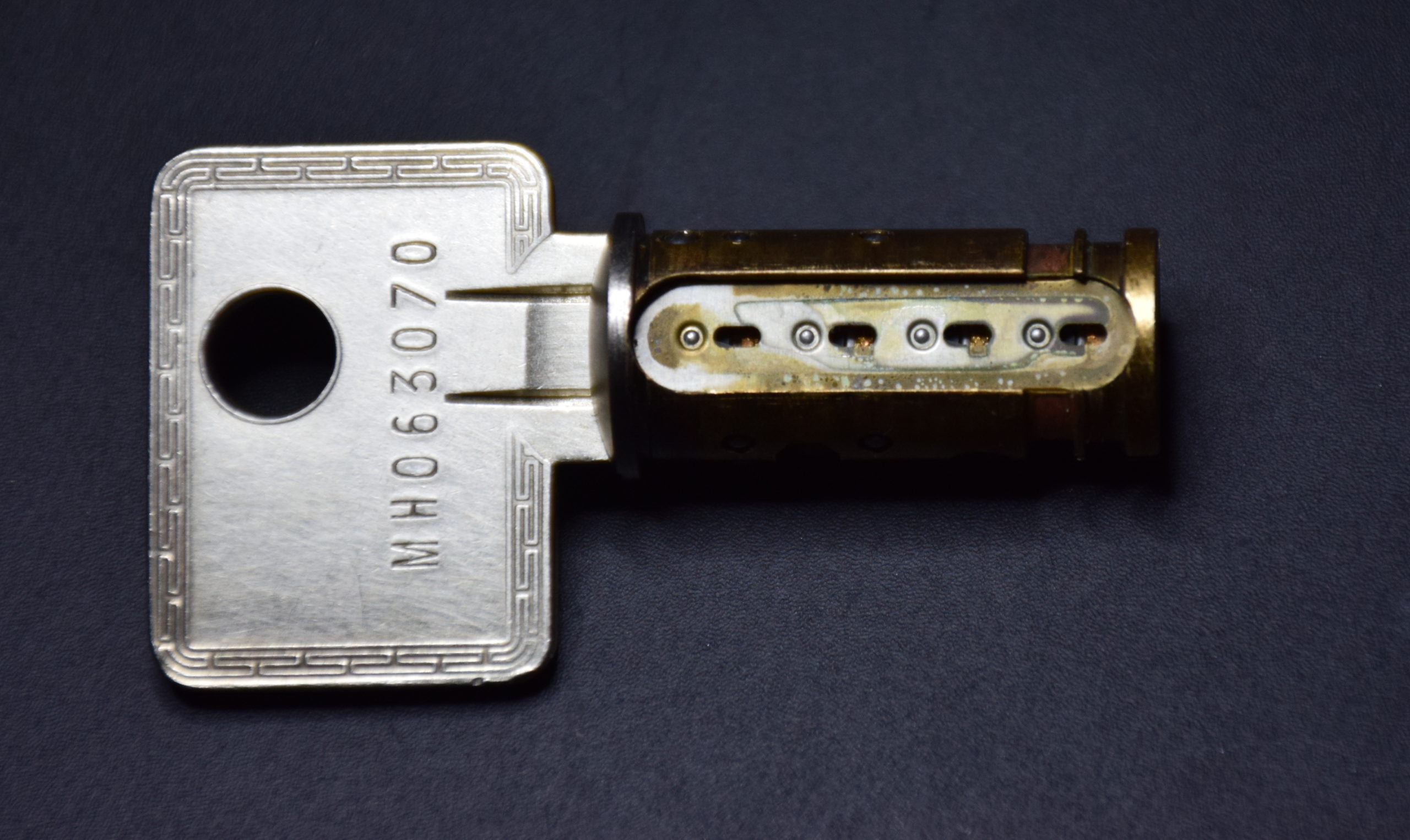
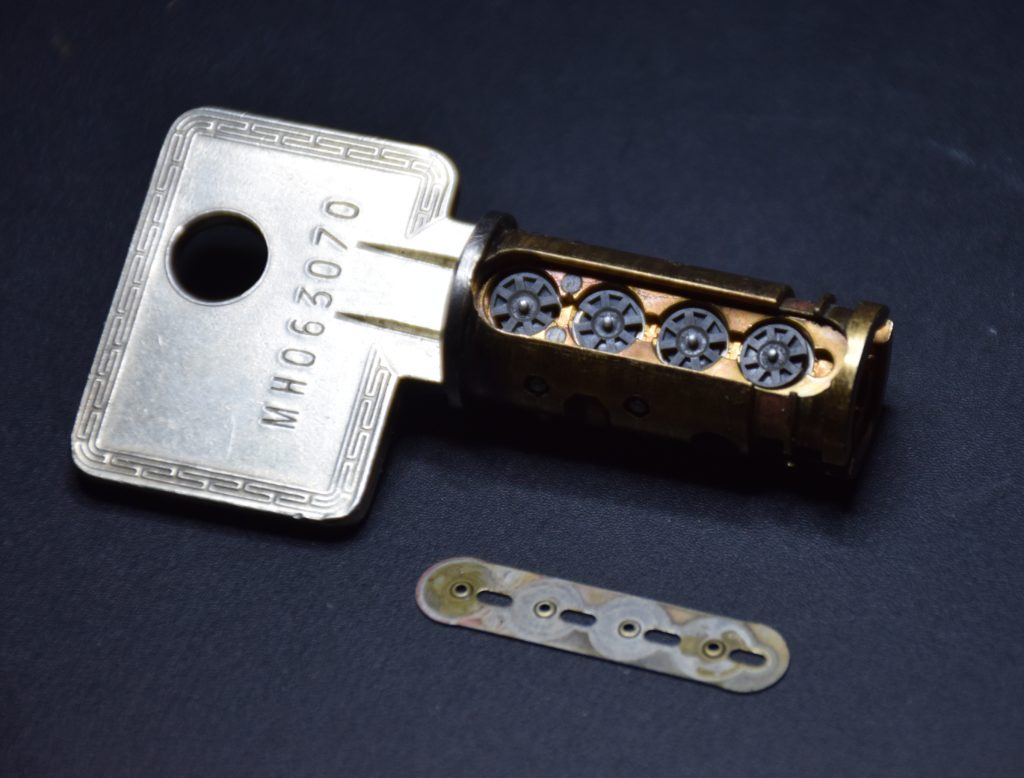
The technology of this atypical lock will remain unchanged until the arrival of the new EVVA MCS in 1995.
La technologie de cette serrure atypique restera inchangée jusqu’à l’arrivée de la nouvelle EVVA MCS en 1995.
Cocolitos
(1) “High-Security Mechanical Locks: An Encyclopedic Reference”, 2007, Graham W. Pulford, Butterworth-Heinemann, p459-463
(2) Austrian patent N°387,065